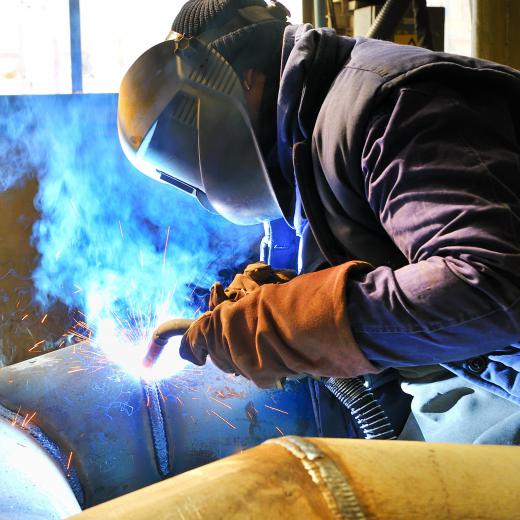At AboutMechanics, we're committed to delivering accurate, trustworthy information. Our expert-authored content is rigorously fact-checked and sourced from credible authorities. Discover how we uphold the highest standards in providing you with reliable knowledge.
What is MIG Welding?
Metal Inert Gas (MIG) welding, also sometimes called Gas Metal Arc Welding (GMAW) is a process that was developed in the 1940s for welding aluminum and other non-ferrous metals. MIG welding is an automatic or semi-automatic process in which a wire connected to a source of direct current acts as an electrode to join two pieces of metal as it is continuously passed through a welding gun. A flow of an inert gas, originally argon, is also passed through the welding gun at the same time as the wire electrode. This inert gas acts as a shield, keeping airborne contaminants away from the weld zone.
The primary advantage of MIG welding is that it allows metal to be welded much more quickly than traditional "stick welding" techniques. This makes it ideal for welding softer metals such as aluminum. When this method was first developed, the cost of the inert gas made the process too expensive for welding steel. Over the years, the process has evolved, however, and semi-inert gases such as carbon dioxide can now be used to provide the shielding function, which now makes MIG welding cost-effective for welding steel.
Besides providing the capability to weld non-ferrous metals, MIG welding has other advantages:
- It produces long, continuous welds much faster than traditional welding methods.
- Since the shielding gas protects the welding arc, this type of welding produces a clean weld with very little splatter.
- It can be used with a wide variety of metals and alloys.
The primary disadvantages of MIG welding include the following:
- The equipment is quite complex, as MIG welding requires a source of direct current, a constant source and flow of gas, as well as the continuously moving wire electrode. Plus, electrodes are available in a wide range of sizes and are made from a number of metal types to match the welding application.
- The actual technique used is different from traditional welding practices, so there is learning curve associated with MIG welding, even for experienced welders. For example, MIG welders may need to push the welding puddle away from them and along the seam.
- The necessity for the inert gas shield means that MIG welding cannot be used in an open area where the wind would blow away the gas shield, unless other precautions are taken to prevent this.

Since its development in the middle of the 20th century, MIG welding has become commonplace in many manufacturing operations. For example, it is commonly used in the automobile industry because of its ability to produce clean welds, and the fact that it welds metals quickly.
AS FEATURED ON:
AS FEATURED ON:















Discussion Comments
Please explain to me the selection of wire diameter, feed rate and gas flow rate. Which is most suitable for welding two different thicknesses of the same material? Example: A 4 mm thick plate to be welded with a 15 mm thick plate. Please let me know the process parameters to be fixed?
I have found that getting the settings right is critical for a successful MIG weld. Of course the settings will vary based on all kinds of things, primarily the type of material and its thickness. Once you have that down, the welding part is pretty easy.
In response to greg. You can buy wire for the mig welder with a flux core. Just like an electrode rod for an arc welder, so you don't have to use gas. When you use this it's known as flux cored arc welding (fcaw).
@gregg1956 -- Gasless MIG welding is done with a different type of wire than regular MIG welding, and requires no welding gas.
This kind of wire is called flux core wire, and is commonly available, though it requires a different machine than regular MIG welding -- you have to either get one that is specifically designed for gasless MIG welding, or one that can do both gasless and regular.
Gasless MIG welding is really popular for little DIY home projects, since it is easy to pick up and doesn't require a lot of investment in materials.
I've heard of something called gasless MIG welding. Now if MIG stands for metal inert gas, how can you have gasless MIG welding.
Any welders out there to explain this to me?
MIG welding really does take a lot of practice to pick up, but it's worth it for the clean welds.
A good MIG welding tip for those starting out is to keep everything as clean as possible, including the wire tip.
There are even attachments that you can use to keep your wire clean as you go, which may be worth the investment if you weld often.
Post your comments